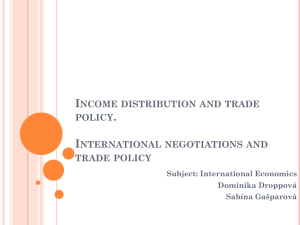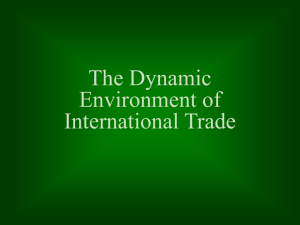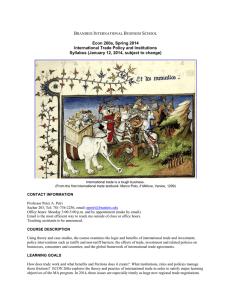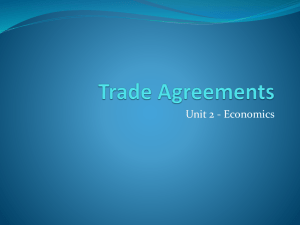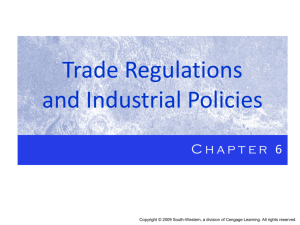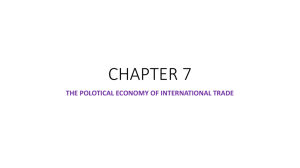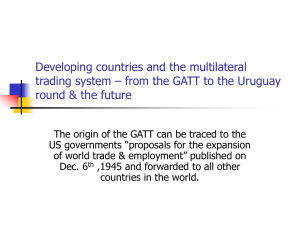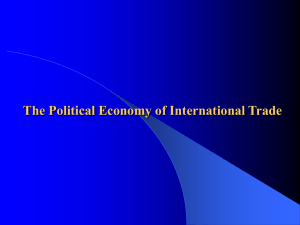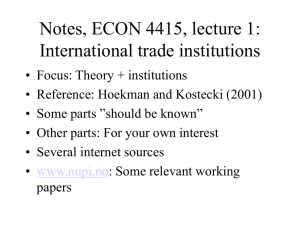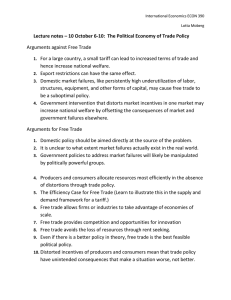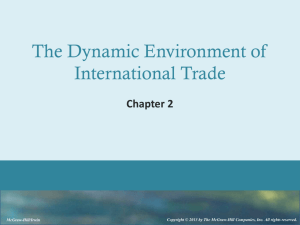Trade diversion
advertisement
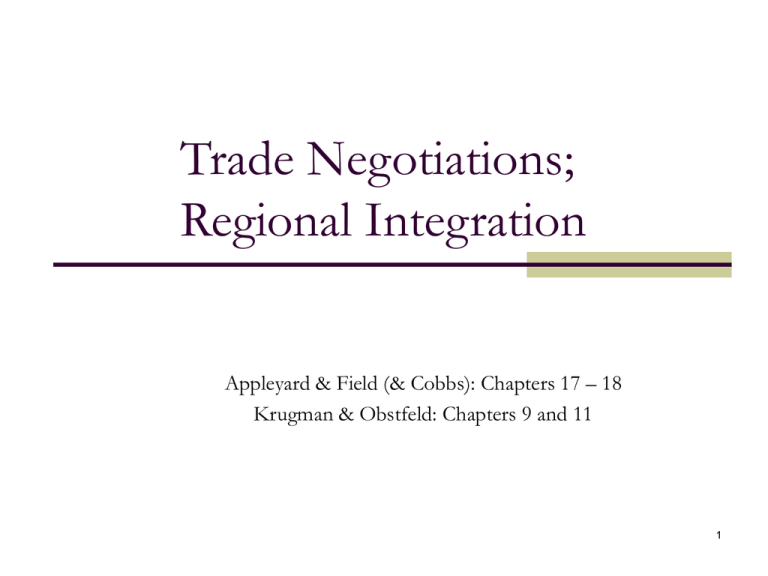
Trade Negotiations; Regional Integration Appleyard & Field (& Cobbs): Chapters 17 – 18 Krugman & Obstfeld: Chapters 9 and 11 1 Trade Negotiations • Bretton Woods Conference (1944) o International Bank for Restructuring and Development (IBRD, later to become the World Bank), International Monetary Fund (IMF), International Trade Organization (ITO) • General Agreement on Tariffs and Trade (GATT) to promote “freer and fairer” trade (1948) • U.S. Senate turns ITO down (1950) 2 Multilateral Trade Negotiations Year Subjects covered Number of countries 13–26 1947–1961 Several negotiations Tariffs 1964–1967 Kennedy Round Tokyo Round Tariffs and anti-dumping measures Tariffs, non-tariff measures, “framework” agreements 102 Uruguay Round Tariffs, non-tariff measures, rules, services, intellectual property, dispute settlement, textiles, agriculture, creation of WTO… 123 1973–1979 1986–1993 62 3 World Trade Organization • GATT becomes WTO (1995) 1. 2. Acts as a forum for trade negotiations Administers trade agreements 1. 2. 3. Settles trade disputes Reviews national trade policies Assists developing countries (technical assistance and training programmes) 4. Cooperates with other international organizations 4 Features of GATT/WTO (1) • Fixed-rule system o unambiguous rules are required to move away from a suboptimal Nash equilibrium • Multilateralism and non-discrimination o Most-favoured-nation (MFN) / normal trade relations (NTR) o Exceptions: 1) free trade areas and 2) GSP for developing countries • Reciprocity o the process evolves trough mutually balanced “concessions” 5 Features of GATT/WTO (2) • Dispute settlement o GATT had expert panels without authority to enforce its recommendations o WTO has a Dispute Settlement Body that can levy fines on countries • Transparency o Tariffs rather than quotas o WTO’s trade-policy-review mechanism • Unresolved issues o agriculture, textiles, shipping, anti-dumping duties, subsidies, FDI, intellectual property rights… 6 Structure of the WTO • Ministerial Conference (at least once every two years) • General Council (ambassadors, several times a year) o meets also as the Trade Policy Review Body and the Dispute Settlement Body • Other: o Goods Council, Services Council and Intellectual Property (TRIPS) Council o Specialized committees, working groups and working parties o Secretariat (technical support; no decision-making role) 7 What’s Next? • The Millenium Round was to be launched in Seattle (1999), but no agreement was found • A new round finally started in Doha (2001) • Issues o agriculture, labour standards, environment, intellectual property, anti-dumping and subsidies, investment, competition policy, transparency in government procurement … • Failure in Cancun (2003) • “Agreement on framework” (2004) 8 Types of Economic Integration (1) • Free trade area (FTA) o o no tariffs between the members each members sets its own tariffs to outside members → outside countries will use a transshipment strategy if no rules of origin exist o e.g. EFTA, NAFTA • Customs Union o free trade area + common external trade policy o e.g. Benelux o 9 Types of Economic Integration (2) • Common Market o customs union + free factor movements o e.g. European Community o • Monetary / Economic Union o common markets + common currency, common institutions and coordination of economic policy o e.g. European Monetary Union o 10 Static Effects of Economic Integration Jacob Viner (1950): The Customs Union Issue. Carnegie Endowment for International Peace, New York. • Two kinds of impacts due to integration o Trade creation: shift from (high-cost) domestic production to (low-cost) a member production o Trade diversion: shift from (low-cost) nonmember production to (high-cost) member production → The welfare impact of economic integration is ambiguous 11 Welfare Impact of Trade Creation • Case 1: Member of integrated of consumer surplus loss of producer surplus loss of government revenue (1+τ)PM decrease of producer surplus tariff increase SD P loss of govn’t revenue area (country M) is the most efficient producer of the good • Before integration, the price in home country is (1+t)*PM • After integration, price becomes PM PM Positive net impact (prior DD deadweight losses) imports before integration Q 12 imports after integration Welfare Impact of Trade Diversion Case 2: Non-member of integrated P area (country O) is the most efficient producer of the good DH • Before integration, the price in home country is (1+t)*PO • After integration, the price is PM increase of consumer surplus (P+a+C+b) loss of producer surplus (P) loss of government revenue (1+τ)PM (C+G) P a P Government loses C+G, but only C M is transferred to consumers PO Net impact is a + b - G • SH b tariff C G Q imports before integration 13 imports after integration Factors Affecting the Net Welfare Impact of Trade Diversion Trade diversion is likely to have less adverse impact on welfare • 1. 2. 3. 4. the closer the member country’s production cost is to the nonmember’s the higher the initial tariff the more elastic supply and demand the more participating countries in integration Other possible static effects of integration • 1. 2. 3. savings in administrative costs possibility to improve the collective terms-of-trade greater bargaining power in trade negotiations 14 Dynamic Effects of Economic Integration • Integration may result different evolution of member countries’ economies than would otherwise have occurred 1. 2. 3. more competition (less monopoly power) access to larger markets → realization of economies of scale greater investment (less restrictions for members + e.g. non- members are more motivated to “get behind the tariff wall” due to larger market available) 4. greater labour mobility 15 Current Trade Blocks • • Andean Community (CAN), Asia-Pacific Economic Cooperation (APEC), Association of Southeast Asian Nations Free Trade Area (AFTA), Caribbean Community and Common Market (CARICOM), East African Economic Community (EAEC), Economic Community of West African States (ECOWAS), European Economic Area (EEA), European Free Trade Association (EFTA), European Union (EU), Mercado Comun del Sur (MERCOSUR or MERCOSUL), Mercado Comun Centro Americano (MCCA), South Asia Association for Regional Cooperation (SAARC), Southern African Development Community (SADC) Proposed: Free Trade Area of the Americas (FTAA), South Asia Free Trade Agreement (SAFTA) 16
